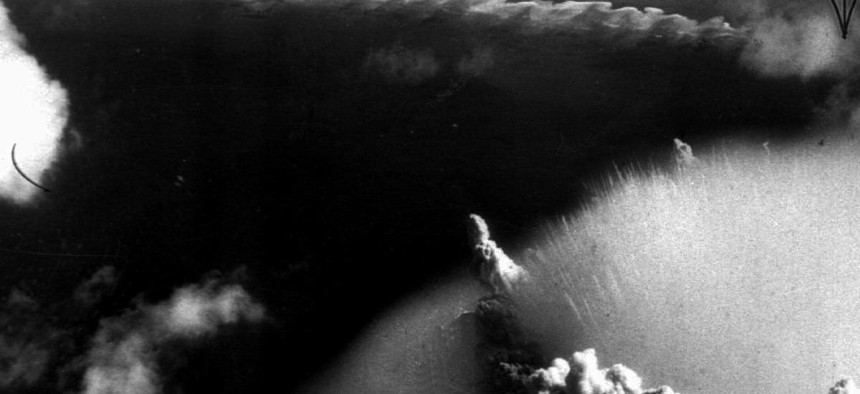
The mushroom cloud of an atomic bomb test at Bikini atoll swamps ships, in 1946. AP Photo
Nuclear Doomsday is Coming Today. You’ll Want to See This.
Joshua, would you like to play Global Thermonuclear War? Then get a load of NUKEMAP 2.0 -- now in 3-D! By Elaine M. Grossman
It’s Thursday, July 18, and nuclear Armageddon is upon us. Or at least you might be excused for thinking so when you glimpse on your colleague’s computer monitor a compelling simulation of a mushroom cloud rising over your home town.
That’s the 2.0 version of NUKEMAP -- now in three dimensions! -- expected for launch by late Thursday, the brainchild of a guy named Alex Wellerstein.
A historian with the American Institute of Physics, Wellerstein has had 3 million visitors to the original two-dimensional edition of his website, who have virtually detonated a whopping 17.4 million nuclear warheads over their choice of locations virtually anywhere around the world.
Launched in February 2012, the initial or “classic” version of NUKEMAP featured your choice of 18 preselected cities -- from Beijing or Berlin to Tehran or Tokyo -- and 23 preset atomic-warhead explosive capacities, or “yields,” numbering in kilotons, or even more stratospheric megatons. A pick of North Korean, Indian, Pakistani, Russian and U.S. bombs was on offer, along with others.
You could have gone wild and plugged in any city across the planet along with a numerical yield for your notional attack, clicked the clearly marked “Detonate” button and wham: A multicolor bulls-eye appeared onscreen, overlaid on your designated city map -- described as a “mashup” of Google Maps and algorithms for nuclear blast effects.
The basic version included a red marker pin affixed with a tiny atomic symbol at your chosen epicenter, inside a golden fireball.
That in turn was ringed by an air blast radius, with pounds-per-square-inch overpressure listed and a fine-print notation that “heavily built concrete buildings are severely damaged or demolished; fatalities approach 100 percent.”
Then there was a wider radiation ring in bright green. The fine print: “500 rem radiation dose; between 50 percent and 90 percent mortality from acute effects alone; dying takes between several hours and several weeks.”
Yet another air blast radius appeared in gray. All of that was ultimately surrounded by an orange-tinted outer thermal radiation ring zone featuring “third-degree burns to all exposed skin” and “fires in flammable materials.”
“It hit this funny intersection between what people called ‘fun’ and ‘scary,’” Wellerstein said at a Thursday event, noting that this is “a really powerful intersection.”
“They often call it a game even though there’s no winning, as with nuclear war,” he said. “They also call it disturbing.”
Problem was, some users of Wellerstein’s original doomsday simulator have been surprised to find that the damage wrought on a city by a relatively low-yield bomb -- say, one of 10 kilotons, the potential size of a North Korean or terrorist nuke -- didn’t look all that catastrophic, he said.
“People lose the sense of scale because the big ones are so outrageously big,” he said.
Enter NUKEMAP 3D, what Wellerstein is billing as “The Next Generation of Do-It-Yourself Nuclear War.”
Once up and running late this week at NuclearSecrecy.com, the new version will introduce three-dimensional city modeling, radioactive fall-out patterns that can be shifted with virtual winds and -- get this -- casualty estimates for the dead and injured, all at the click of a mouse.
The new ticker shows that hundreds of thousands of deaths could be expected even from a typical-size nuclear bomb detonated in a rural area -- for example, the site of a tank-manufacturing plant or a nuclear complex facility, where one might think population losses would be minimal.
“So, suddenly now, that little tiny bomb that the North Koreans made suddenly looks like actually a pretty bad deal,” Wellerstein said. “You can also turn on a little button here ... called ‘humanitarian impact,’ where it will calculate, along with the fatalities, how many hospitals, fire stations, schools and religious institutions you destroy.”
He said the software is intended to “educate” without offering information about locations or potential casualties that a would-be terrorist or adversary nation could not easily find elsewhere.
The 3-D version, demoed at Thursday’s public roll-out, allows a viewer to see while taking off from Ronald Reagan National Airport, for instance, a bright yellow airburst fireball suspended over the White House, a death bubble poised to burst.
“This is what that would look like from an airplane,” Wellerstein said. “You can see that sort of giant sun out your window, but probably not for very long.”
NEXT STORY: Stopping the Next Benghazi Through Technology




